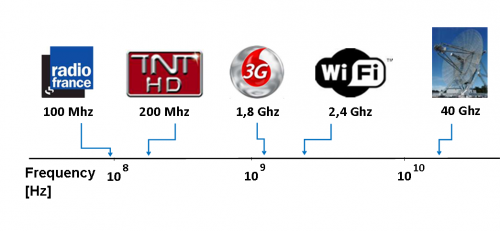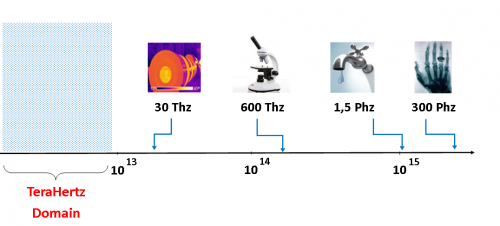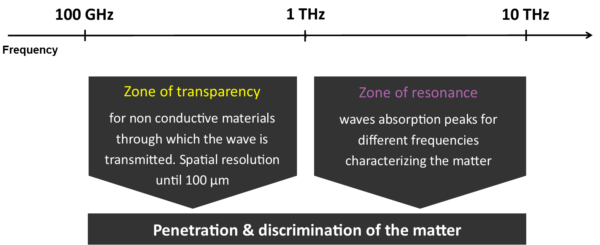For many years confined to astronomical observation, terahertz (THz) optronic technologies have more recently been of interest to new application sectors, mainly non-destructive evaluation and testing (NDT&E). Some technological steps have been taken, besides, components and systems that meet the expectations of the scientific and industrial sectors are now proposed.
Improved internal understanding of new materials and their performances and the optimization in setting up manufacturing processes using inner material data are at the heart of these expectations, thereby accounting for the permanent search for new means of inspecting and characterising the material.
This research is also justified by the diversity of material or process problems to be studied drawing on not one technology alone, but complementary technologies.


Of all existing non-destructive evaluation and testing technologies, THz technologies stand out for their duality at several levels. Firstly, due to their situation in the electromagnetic field, between two worlds – radio frequencies and optics -; THz technologies borrow from the first the penetrating nature in dielectric materials and from the second the capacity to focus on and access a certain submillimetric spatial resolution. Secondly, they show themselves to be extremely appropriate for penetrating imaging whilst proposing spectroscopic relevance.

Interesting physical properties of terahertz waves (THz)
• THz waves are located between infrareds and microwaves in the electromagnetic spectrum. 1 THz (=10^12Hz) corresponds to a wavelength of 300 µm. THz waves penetrate a large number of materials (an advantage over infrareds) and provide greater spatial resolution than microwaves.
• Penetration is relatively deep for many dielectric materials like plastics, ceramics, plaster, paper, cardboard and textiles. THz imaging can be used to analyse the internal structure of materials to detect and locate in depth their faults, inclusions, contaminations etc. or to characterise their physical properties. The TeraHertz thickness measurement allows you to access the individual thickness values of a multilayer material.
• Many substances like medicines, narcotics, explosive agents, etc. that undergo THz radiation show characteristic spectral signatures due to excitation modes of their molecular arrangement. Thus, THz spectroscopy can identify substances or characterise their chemical properties (composition, molecular spatial arrangement, etc.)
• The propagation of THz waves through the air, even when damp, shows no major mitigation; this property gives the THz technologies an extremely useful contactless measuring ability (advantage over ultrasounds) for controlling large parts or controlling products on a production line in real time.
• THz waves are not ionising; the energy levels generated are in the order of 4 meV for 1 THz, far from X-ray energy levels (≈KeV). The energy of the THz photon is comparable to that received by thermal radiation in a room at 20°C.
